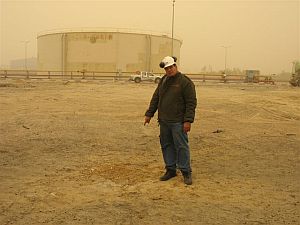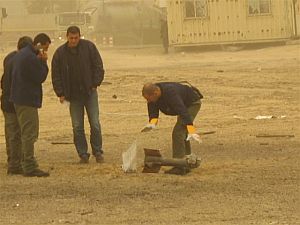Israel Courting Kassam Catastrophe
Excerpts;
Israel appears content to simply wait for disaster after a Kassam rocket attack that nearly ended in catastrophe when it landed just meters from hazardous materials in Ashkelon Tuesday elicited little more than a token response.
The rocket, fired by Palestinian Arabs operating out of northern Gaza, landed inside Ashkelon’s vulnerable southern industrial district, dangerously close to substances that if ignited would have devastating consequences.
Despite this clear and present danger, Israel’s response continues to be the shelling of fields and empty buildings in Gaza, and the occassional targeted assassination of a known terrorist field commander. It is obviously not having the desired effect, as the rocket barrages have become a near daily occurance.
Acting Prime Minister Ehud Olmert has even gone so far as to assert that the Hamas-ruled “Palestinian” territories do not pose “a strategic threat” to Israel.
Observers believe it is only a matter of time before one of these rockets finds its mark in Ashkelon and changes Olmert’s mind.
Nine Kassams Fired at Israel in 24 Hours
Four Shock Victims in Hospital Following Kassam Attack
Kassam Hits Factory in Kibbutz Zikim
Excerpts;
A Kassam rocket fired from northern Gaza hit a mattress factory in Kibbutz Zikim Thursday morning, starting a small fire in the factory.
One person suffered from shock as a result of the attack, and was taken to hospital for treatment.
Disengagement’s Military Lesson for the West Bank
For a graphic idea of what we’re talking about, click here (compliments of IRIS). As one can clearly see in these reports, the Kassam calibrations are getting ever closer.
Excerpts;
The disengagement policy adopted by Ariel Sharon with respect to the Gaza Strip has now become the policy of Hitkansut – a term which does not easily translate into English, but has connotations of “circling the wagons” and “pulling in” or “ingathering.” The best way to think of this is to use an analogy. When a turtle is frightened, it pulls its head and limbs into its shell – that is Hitkansut in a nutshell.
This “Turtle Strategy” is based on the same premise a turtle uses when in danger, pull back and hide inside a protected zone – in this case, behind the security barrier. While this may work, in most cases, for turtles – given the kinds of threats that they face, it seems hopelessly na ve and ineffectual as the basis for Israeli policy.
The unilateral withdrawal policy, on the other hand, was based on the idea that Israel could live with a political/security vacuum on the Palestinian side.
It is not likely that Israel will be able to do so much longer, with respect to Gaza, now that the Palestinians have devised even more effective ways to strike at Israel from the Strip. Olmert’s proposed policy takes the same principle applied to Gaza and shifts it to the West Bank thus putting Israel’s central population centers within rocket and missile range.
The strategy that works for the turtle will not be as effective for Israel. If Israel comes under increasing attacks in the wake of further withdrawals, and yet continues to insist that this policy will create greater security, we will know that the next Israeli government no longer holds to the turtle strategy – it will have then adopted an “ostrich strategy.”


